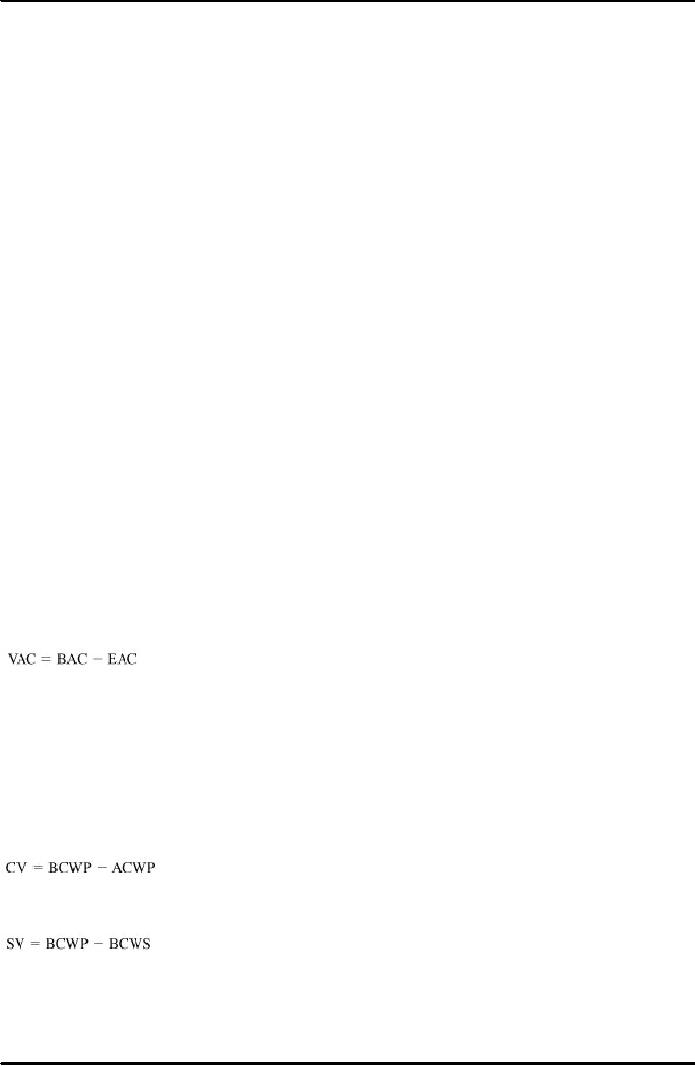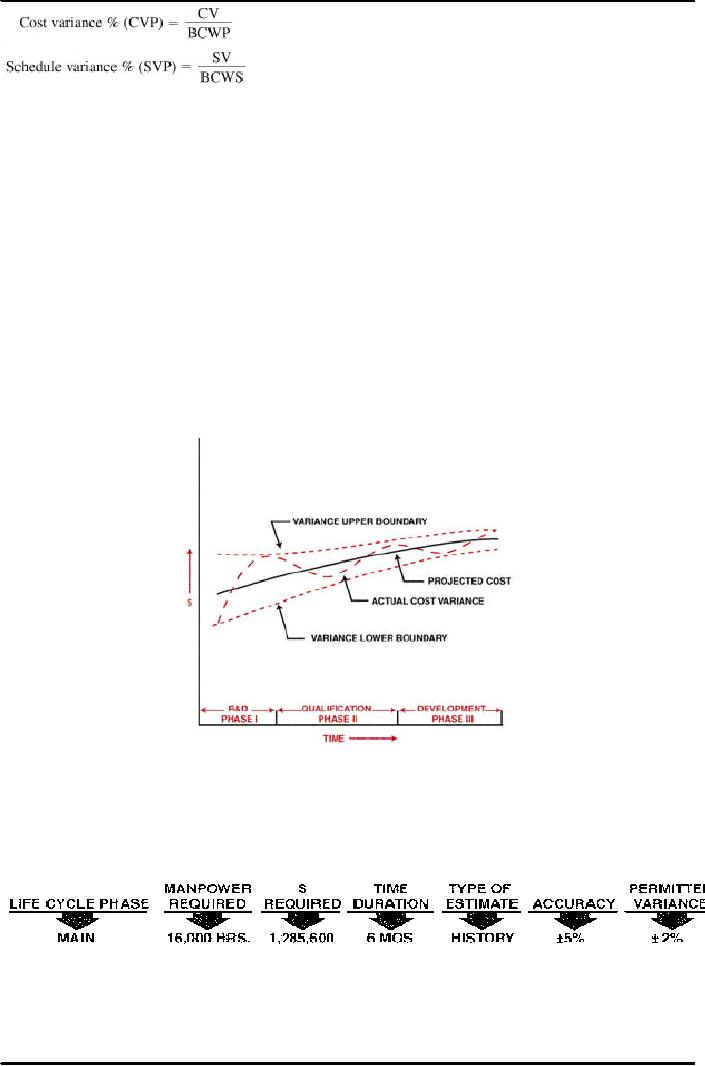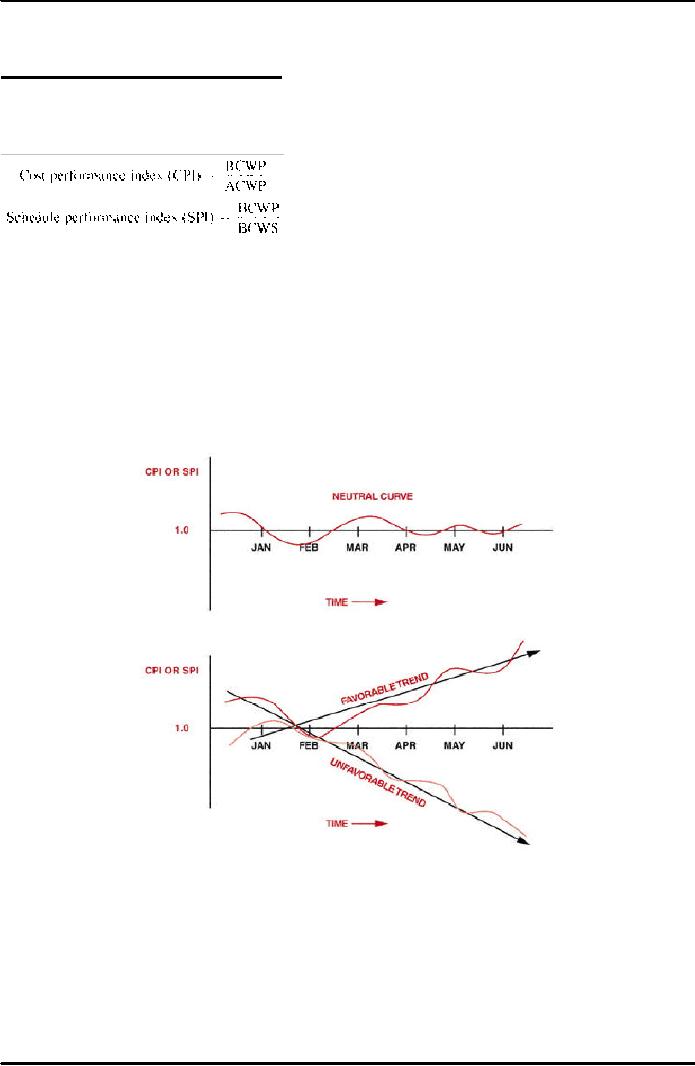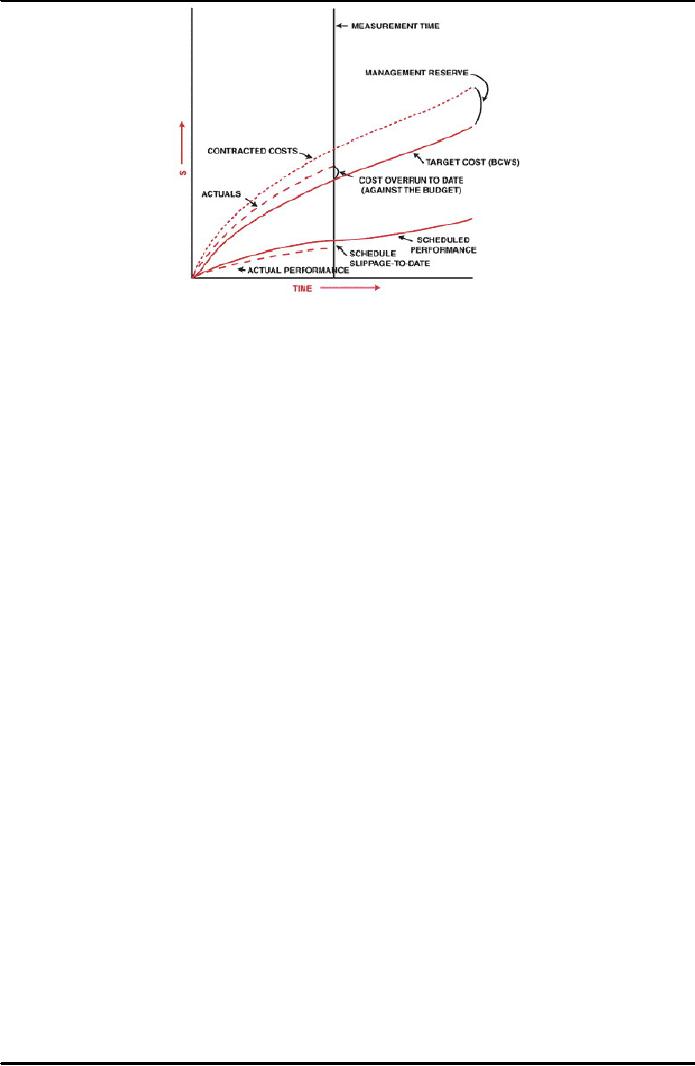 |

Project
Management MGMT627
VU
LESSON
41
COST
MANAGEMENT AND CONTROL IN
PROJECTS
BROAD
CONTENTS
Budget
Variances
& Earned Value
ACWP,
BCWS, BCWP
Cost
& Schedule Variance
CPI,
SPI
Variance
Analysis (V/A)
Depreciation
& Ethics
41.1
Budgets
The
project budget, which is the
final result of the planning
cycle of the MCCS, must be
reasonable,
attainable,
and based on:
�
Contractually
Negotiated Costs And
�
The
Statement of Work.
The
basis for the budget
is:
�
Historical
Cost,
�
Best
Estimates, Or
�
Industrial
Engineering Standards.
The
budget must identify:
�
Planned
Manpower Requirements,
�
Contract
Allocated Funds, And
�
Management
Reserve.
All
budgets must be traceable through the
budget "log," which
includes:
�
Distributed
budget
�
Management
reserve
�
Undistributed
budget
�
Contract
changes
Management
reserve is the dollar amount established by the
project office to budget for
all categories of
unforeseen
problems and contingencies resulting in out-of-scope
work to the performers. Management
reserve
should be used for tasks or
dollars, such as rate changes, and
not to cover up bad
planning
estimates
or budget overruns. When a significant
change occurs in the rate structure, the
total
performance
budget should be adjusted.
In
addition to the "normal" performance
budget and the management reserve
budget, there also exists
the
following: Undistributed budget,
which is that budget
associated with contract changes where
time
constraints
prevent the necessary planning to
incorporate the change into the
performance budget. (This
effort
may be time-constrained.) Unallocated
budget, which represents a
logical grouping of contract
tasks
that have not yet been
identified and/or
authorized.
41.2
Variance
Variance
is defined as any schedule,
technical performance, or cost deviation
from a specific plan.
Variances
are used by all levels of
management to verify the budgeting
system and the scheduling
system.
The budgeting and scheduling
system variance must be
compared together
because:
The
cost variance compares
deviations only from the
budget and does not provide
a measure of
comparison
between work scheduled and work
accomplished.
321

Project
Management MGMT627
VU
The
scheduling variance provides a comparison
between planned and actual performance but
does not
include
costs.
There
are two primary methods of
measurement:
Measurable
efforts: discrete
increments of work with a definable
schedule for accomplishment,
whose
completion
produces tangible
results.
Level
of effort: work
that does not lend
itself to subdivision into
discrete scheduled increments of
work,
such
as project support and project
control.
41.2.1
Variances
are used on both types of
measurement. In order to calculate variances
we
must
define the three basic variances for
budgeting and actual costs for
work scheduled and
performed.
Archibald
defines these
variables:
Budgeted
cost for work scheduled
(BCWS) is the budgeted
amount of cost for work
scheduled to be
accomplished
plus the amount or level of
effort or apportioned effort
scheduled to be accomplished in a
given
time period.
Budget
cost for work performed
(BCWP) is the budgeted
amount of cost for completed
work, plus
budgeted
for level of effort or
apportioned effort activity completed
within a given time period.
This is
sometimes
referred to as "earned
value."
Actual
cost for work performed
(ACWP) is the amount
reported as actually expended in
completing
the
work accomplished within a given
time period.
Planned
Value (PV) What
Plan should be worth at this
point in "Schedule". Also
BCWS: Budgeted
amount
of "Cost for work Schedule"
to be accomplished Plus "Amount or level
of effort for
"Schedule"
to
be Accomplished at a given time
period.
Earned
Value (EV) Physical
work completed to date &
with in authorized "Budget"
for that.
The
budget at completion is the sum of
all budgets (BCWS) allocated
to the project. This is
often
synonymous
with the project baseline. This is
what the total effort should
cost. The estimate at
completion
identifies either the dollars or hours
that represent a realistic appraisal of
the work when
performed.
It is the sum of all direct
and indirect costs to date
plus the estimate of all
authorized work
remaining
(EAC = cumulative actuals + the
estimate-to-complete).
Using
the above definitions, we can calculate the
variance at completion
(VAC):
The
estimate at completion (EAC) is the
best estimate of the total
cost at the completion of the
project.
The
EAC is a periodic evaluation of the
project status, usually on a
monthly basis or until a
significant
change
has been identified. It is
usually the responsibility of the
performing organization to prepare
the
EAC.
These
costs can then be applied to
any level of the work
breakdown structure (i.e., program,
project,
task,
subtask, work package) for
work that is completed, in-program, or
anticipated. Using
these
definitions,
the following variance definitions
are obtained:
Cost
variance (CV)
calculation:
A
negative variance indicates a
cost-overrun condition.
Schedule
variance (SV)
calculation:
A
negative variance indicates a behind-schedule
condition.
In
the analysis of both cost and schedule,
costs are used as the lowest
common denominator. In other
words,
the schedule variance is given as a
function of cost. To alleviate
this problem, the variances
are
usually
converted to percentages:
322

Project
Management MGMT627
VU
The
schedule variance may be
represented by hours, days, weeks, or
even dollars.
As
an example, consider a project that is
scheduled to spend $100K for
each of the first four weeks
of
the
project. The actual expenditures at the
end of week four are $325K.
Therefore, BCWS = $400K
and
ACWP
= $325K. From these two
parameters alone, there are several
possible explanations as to
project
status.
However, if BCWP is now
known, say $300K, and then
the project is behind schedule
and
overrunning
costs.
Variances
are almost always identified as
critical items and are reported to
all organizational
levels.
Critical
variances are established for each
level of the organization in accordance
with management
policies.
Not
all companies have a uniform
methodology for variance thresholds.
Permitted variances may be
dependent
on such factors as:
�
Life-cycle
phase
�
Length
of life-cycle phase
�
Length
of project
�
Type
of estimate
�
Accuracy
of estimate
Figure
41.1: Project variance
projections
Figure
41.1 shows time-phased cost variances
for a program requiring
research and development,
qualification,
and production phases. Since the
risk should decrease as time
goes on, the variance
boundaries
are reduced. Figure 41.2
shows that the variance
envelope in such a case may
be dependent
on
the type of estimate.
Figure
41.2: Methodology to variance
By
using both cost and schedule
variance, we can develop an
integrated cost/schedule reporting
system
that
provides the basis for
variance analysis by measuring cost performance in
relation to work
323

Project
Management MGMT627
VU
accomplished.
This system ensures that
both cost budgeting and performance
scheduling are constructed
on
the same database.
COST
PERFORMANCE INDEX
(CPI)
41.2.2
In
addition to calculating the cost
and schedule variances in terms of
dollars or
percentages,
we also want to know how
efficiently the work has
been accomplished. The formulas
used
to
calculate the performance efficiency as a
percentage of BCWP
are:
If
CPI = 1.0, we have perfect performance.
If CPI > 1.0, we have exceptional
performance. If CPI < 1.0,
we
have poor performance. The same analysis
can be applied to the
SPI.
Variance
Analysis
41.2.3
The
cost and schedule performance index is
most often used for
trend analysis as shown
in
Figure 41.3. Companies use
either three-month, four-month, or
six-month moving averages to
predict
trends.
The usefulness of trend analysis is to
take corrective action to
alleviate unfavorable trends
by
having
an early warning system.
Unfortunately, effective use of
trend analysis may be restricted to
long-
term
projects because of the time needed to
correct the situation.
Figure
41.3: The performance
index
Figure
41.4 shows an integrated
cost/schedule system. The
figure identifies a performance slippage
to
date.
This might not be a bad
situation if the costs are
proportionately under-run. However,
from the
upper
portion of Figure 41.4, we
find that costs are
overrun (in comparison to budget
costs), thus adding
to
the severity of the situation.
324

Project
Management MGMT627
VU
Figure
41.4: Integrated cost/schedule
system
Also
shown in Figure 41.4 is the management
reserve. This is identified as the
difference between the
contracted
cost for projected performance to
date and the budgeted cost. Management
reserves are the
contingency
funds established by the program manager
to counteract unavoidable delays that can
affect
the
project's critical path.
For
variance analysis, goal of cost
account Manager To take
action that will correct
problem within
original
budget or justify a new
estimation.
Five
Questions must be addressed
during variance
analysis:
�
What
is the problem causing the variance?
�
What
is the impact on time, cost, and
performance?
�
What
is the impact on other efforts, if
any?
�
What
corrective action is planned or
under way?
�
What
are the expected results of the
corrective action?
One
of the key parameters used in
variance analysis is the "earned value"
concept, which is the same as
BCWP.
Earned value is a forecasting variable
used to predict whether the
project will finish over
or
under
the budget. As an example, on June 1, the
budget showed that 800 hours
should have been
expended
for a given task. However,
only 600 hours appeared on the
labor report. Therefore,
the
performance
is (800/600) � 100, or 133 percent, and
the task is under running in performance.
If the
actual
hours were 1,000, the performance would be 80 percent,
and an overrun would be
occurring.
The
difficulty in performing variance
analysis is the calculation of BCWP
because one must predict
the
percent
complete. To eliminate this problem,
many companies use standard
dollar expenditures for
the
project,
regardless of percent complete. For
example, we could say that
10 percent of the costs are to be
"booked"
for each 10 percent of the time
interval. Another technique, and
perhaps the most common, is
the
50/50 rule:
50/50
rule
Half
of the budget for each element is
recorded at the time that
the work is scheduled to
begin, and the
other
half at the time that
the work is scheduled to be completed.
For a project with a large
number of
elements,
the amount of distortion from such a
procedure is minimal. 50/50 rule
eliminate the necessity
for
the continuous determination of percent
complete.
41.3
Depreciation
41.3.1
Depreciation
is the technique used to compute
"Estimated value" of any
object after
few
years. Some types
are:
325

Project
Management MGMT627
VU
1.
Straight line depreciation
same amount deprecated (reduced) from
cost each year.
2.
Double-declining balance First
year - high "Deduction in
value" Twice amount of straight
line.
Each
year after that deduction
40% less than previous
year.
3.
Sum of year depreciation If
life - 5 years. Total of 1-5
is 15 first year deduce 5/15
from cost, in 2nd
year
Deduce 4/15, & so
on.
41.3.2
Parametric
Modeling Estimation
This
is the use of mathematical model to make
estimation. Following are the
two types of PME.
Regression
Analysis: Mathematical
model based upon historical
information.
Learning
Curve: Model
based upon principal
Cost/unit describes as more work,
Gets completed.
41.3.3
Analogous
Estimating
Estimation
technique with characteristics
Estimation based on past
Project (historical information)
less
accurate
compared to bottom-up estimation
Top-down approach Takes less
time compared to
bottom-up
estimation
Form of an expert
judgment.
41.3.4
Ethics
Ethics
are standards of right &
wrong that influence
behavior. Right behavior is considered
ethical &
wrong
behavior is considered unethical. Major
concern to both managers &
employee.
A
set of beliefs about right
& wrong principles of conduct
governing an individual or a group
behavior
that
is fair & just, over & above
obedience to laws & regulations
Ethics
guide people in dealings
with stack holders & others, to
determine appropriate actions.
Project
Manager
often must choose between the
conflicting interests of
stakeholders.
326
Table of Contents:
- INTRODUCTION TO PROJECT MANAGEMENT:Broad Contents, Functions of Management
- CONCEPTS, DEFINITIONS AND NATURE OF PROJECTS:Why Projects are initiated?, Project Participants
- CONCEPTS OF PROJECT MANAGEMENT:THE PROJECT MANAGEMENT SYSTEM, Managerial Skills
- PROJECT MANAGEMENT METHODOLOGIES AND ORGANIZATIONAL STRUCTURES:Systems, Programs, and Projects
- PROJECT LIFE CYCLES:Conceptual Phase, Implementation Phase, Engineering Project
- THE PROJECT MANAGER:Team Building Skills, Conflict Resolution Skills, Organizing
- THE PROJECT MANAGER (CONTD.):Project Champions, Project Authority Breakdown
- PROJECT CONCEPTION AND PROJECT FEASIBILITY:Feasibility Analysis
- PROJECT FEASIBILITY (CONTD.):Scope of Feasibility Analysis, Project Impacts
- PROJECT FEASIBILITY (CONTD.):Operations and Production, Sales and Marketing
- PROJECT SELECTION:Modeling, The Operating Necessity, The Competitive Necessity
- PROJECT SELECTION (CONTD.):Payback Period, Internal Rate of Return (IRR)
- PROJECT PROPOSAL:Preparation for Future Proposal, Proposal Effort
- PROJECT PROPOSAL (CONTD.):Background on the Opportunity, Costs, Resources Required
- PROJECT PLANNING:Planning of Execution, Operations, Installation and Use
- PROJECT PLANNING (CONTD.):Outside Clients, Quality Control Planning
- PROJECT PLANNING (CONTD.):Elements of a Project Plan, Potential Problems
- PROJECT PLANNING (CONTD.):Sorting Out Project, Project Mission, Categories of Planning
- PROJECT PLANNING (CONTD.):Identifying Strategic Project Variables, Competitive Resources
- PROJECT PLANNING (CONTD.):Responsibilities of Key Players, Line manager will define
- PROJECT PLANNING (CONTD.):The Statement of Work (Sow)
- WORK BREAKDOWN STRUCTURE:Characteristics of Work Package
- WORK BREAKDOWN STRUCTURE:Why Do Plans Fail?
- SCHEDULES AND CHARTS:Master Production Scheduling, Program Plan
- TOTAL PROJECT PLANNING:Management Control, Project Fast-Tracking
- PROJECT SCOPE MANAGEMENT:Why is Scope Important?, Scope Management Plan
- PROJECT SCOPE MANAGEMENT:Project Scope Definition, Scope Change Control
- NETWORK SCHEDULING TECHNIQUES:Historical Evolution of Networks, Dummy Activities
- NETWORK SCHEDULING TECHNIQUES:Slack Time Calculation, Network Re-planning
- NETWORK SCHEDULING TECHNIQUES:Total PERT/CPM Planning, PERT/CPM Problem Areas
- PRICING AND ESTIMATION:GLOBAL PRICING STRATEGIES, TYPES OF ESTIMATES
- PRICING AND ESTIMATION (CONTD.):LABOR DISTRIBUTIONS, OVERHEAD RATES
- PRICING AND ESTIMATION (CONTD.):MATERIALS/SUPPORT COSTS, PRICING OUT THE WORK
- QUALITY IN PROJECT MANAGEMENT:Value-Based Perspective, Customer-Driven Quality
- QUALITY IN PROJECT MANAGEMENT (CONTD.):Total Quality Management
- PRINCIPLES OF TOTAL QUALITY:EMPOWERMENT, COST OF QUALITY
- CUSTOMER FOCUSED PROJECT MANAGEMENT:Threshold Attributes
- QUALITY IMPROVEMENT TOOLS:Data Tables, Identify the problem, Random method
- PROJECT EFFECTIVENESS THROUGH ENHANCED PRODUCTIVITY:Messages of Productivity, Productivity Improvement
- COST MANAGEMENT AND CONTROL IN PROJECTS:Project benefits, Understanding Control
- COST MANAGEMENT AND CONTROL IN PROJECTS:Variance, Depreciation
- PROJECT MANAGEMENT THROUGH LEADERSHIP:The Tasks of Leadership, The Job of a Leader
- COMMUNICATION IN THE PROJECT MANAGEMENT:Cost of Correspondence, CHANNEL
- PROJECT RISK MANAGEMENT:Components of Risk, Categories of Risk, Risk Planning
- PROJECT PROCUREMENT, CONTRACT MANAGEMENT, AND ETHICS IN PROJECT MANAGEMENT:Procurement Cycles